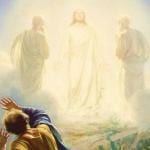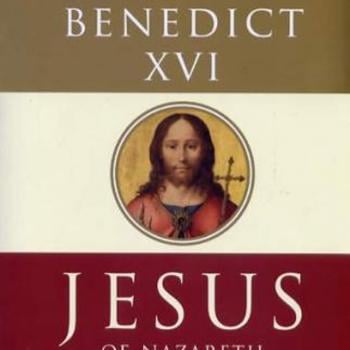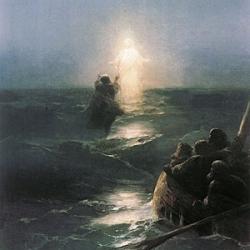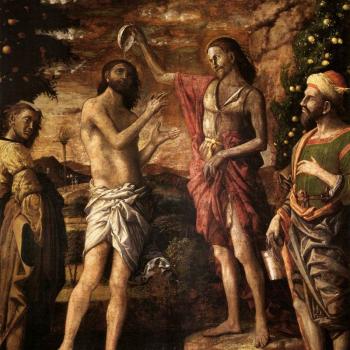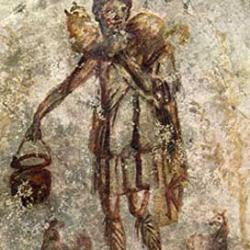Where One is Three
Only as God can be
Father, Son and Holy Spirit
Problem? God can hear it
True Love in Love in Love
A father, a God person, a symbol dove
It is a mystery, a God gift
In our soul the Trinity lift
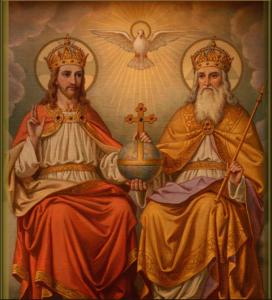
For to us Trinitarians (if I may say it with reverence) – to us God Himself is a society. It is indeed a fathomless mystery of theology, and even if I were theologian enough to deal with it directly, it would not be relevant to do so here. Suffice it to say here that this triple enigma is as comforting as wine and open as an English fireside; that this thing that bewilders the intellect utterly quiets the heart: but out of the desert, from the dry places and, the dreadful suns, come the cruel children of the lonely God; the real Unitarians who with scimitar in hand have laid waste the world. For it is not well for God to be alone.
G.K. Chesterton, The Romance of Orthodoxy, chapter 8 Orthodoxy,
Trinity Sunday is the day we commemorate the in-explainable doctrine that underlines our entire belief in the concept of God. Trinity Sunday is the day I originally meant to publish this, but I didn’t finish it on time, so I decided to publish it the day after the solemnity of the transfiguration.
We as Catholics are monotheists meaning we believe there is one God. We share this belief with the Jewish and Muslim faiths. Jewish theology is the foundation for Christianity and Islam. It’s interesting to note that Jews did not start out as monotheists.
The Jews were not always monotheists. They inhabited Mesopotamia in the midst of various, and usually hostile, cultures. Each worshiped their own particular god. Chemosh was the god of Moab, Milcom the god of the Ammonites, Qaus the god of the Edomites, and Yahweh was the God of the Israelites. The gods united their people into a nation and secured them in their identity. No one culture denied the existence of the others’ god — they simply saw them as warring powers.
The revelation that “I am the LORD; there is no other God” (Isaiah 45:5) was earth-shattering. It destroyed the polytheism that localized and limited the Goodness of the Divine to nationalistic power. Though the Jews were notorious “backsliders,” worshiping national gods again and again, the prophets eventually drove the point of monotheism through their hearts: Yahweh alone is God. The rest are false gods, idols and non-entities: “For all the gods of the nations are idols, but the LORD made the heavens.” (Psalm 96)
Marc Barnes, Identity Politics: The New Polytheism (January 9, 2017) Bad Catholic @Patheos Catholic
Divine revelation seems to drip slowly from the infinite to his finite earthly creation as God reveals himself over the centuries. First God reveals himself as one and then as 3 distinct persons, but still only one God. 3 in 1. Say what? As Christians who believe in the Trinity, and who are baptized in the name of the Father, Son and Holy Spirit, many of us have trouble really explaining the 3 persons in one God to anyone. It is easier to brush it off as something you just believe, because you might have trouble explaining the crazy concept to anyone who might want to dig deeper instead of just trusting what they learned in catechism class as a child.
We face the same dilemma as St. Augustine.
I’ll bet many of you know the old story of St. Augustine walking along the beach one day, taking a break from writing his treatise on the Trinity, whose Solemnity we celebrate this week. The great scholar just couldn’t get his mind around this great mystery. The story goes that he saw a little boy digging a hole in the sand, and then running to the ocean, filling up his hands with the seawater, running back to the hole and emptying the water into the hole. Augustine watched as the child went back and forth several times. Finally he said to the boy, “What are you doing?” The boy said, “Trying to fill that hole with the ocean.” And Augustine said, “You’ll never fit the ocean in that hole.” And the boy said, “Neither will you be able to fit the Trinity into your mind.”
James Martin, S.J. , St. Augustine’s puzzle: how can we understand the Trinity? (June 14, 2019) America Magazine
A faithful and overwhelmed Catholic might respond, “See even Dr. Augustine couldn’t get it and he was a holy smart saint. Me, I’m just a dumb lay person. Please do not ask me why Jesus prayed to the Father; He is also God after all. Why was the Holy Spirit, the Paraclete sent down when Jesus had already done His earthly work as fully human and fully divine and we already knew that God was our Father? My answer would be, I don’t know. The church teaches it and anyway it is in the Bible. It’s a mystery. Done and Closed.”
Okay. There is no reason to throw in the metaphysical towel. The church through the centuries has done its children the great service of unraveling this great mystery of faith and has given us many good explanations of it through saints, theologians and other faithful Catholic thinkers. We also have analogies and images that try and help shape our thoughts. When we imagine God as Father, Son and Spirit we think of the three in one. We may have been taught to imagine 2 people and a dove all equaling God. We might imagine a shamrock or any one object that has three pieces to help us understand. But God is so much more than what a 3-leaf clover can cover. He is The God who can do anything. God does not have to look like things we can see on Earth. God does not have a gender. Humans need something tangible, something they can relate to because “Eye has not Seen, nor Ear heard: 1 Corinthians 2:9” While this verse speaks of heaven might it also speak of our Triune God?
Sigh. Okay. Donall and Conall do a much better job of explaining the Trinity then I can.
Another way of looking at God besides a spiritual formula is to think of him as a family.
“God in his deepest mystery is not a solitude but a family, since he has in himself fatherhood, sonship and the essence of the family which is love.”—John Paul II
A family of singers, united in one song are individual distinct voices, but are one in chorus.
The family of stories consisting of The Fellowship of the Rings, The Two Towers and The Return of the King are three distinct books but One complete Story.
A woman came from the rib of man. The two are separate but when they engage in the marginal act, they become one flesh. The love between them is a person whom they give a name nine months later. Unless it’s twins or triplets, then they have to come up with more names.
The concept of family is often best expressed, not in high falutin jargon but in poetry (like the one above).
I often feel that poetic language fits the mystery better than sterile philosophical terms. There are many quotes from the saints that fulfill this mystical quality, and which I wish more non-Christians familiarized themselves with before broaching the discussion topic. It also helps to show the way in which the Trinity is spoken of in Christian devotional life, as a living, breathing force of faith.
For example, St. John of the Cross wrote: “The Blessed Trinity inhabits the soul by divinely illuminating its intellect with the wisdom of the Son, delighting its will in the Holy Spirit and absorbing it powerfully and mightily in the unfathomed embrace of the Father’s sweetness.”
Avellina Balestri, The Talk of the Three-in-One (June 7, 2020) Longbows & Rosary Beads@ Patheos Catholic
So, to conclude.
The Trinity is a Mystery.
The Church gives us explanations and analogies to help us understand the Mystery.
The concept of the Family is the best explanation of this mystery and is best expressed in poetry.
No Catholic should be overwhelmed by trying to explain an ocean sized concept from their pea-sized brain.
Go and ponder what you have learned
In the Name of the Father,
In the Name of the Son, and
In the Name of the Holy Spirit.
Amen.
Extra Bonus:
One of the best explanations of the Trinity I have ever read…
Perhaps the best way to think of it is this. I asked you just now to imagine those two books, and probably most of you did. That is, you made an act of imagination and as a result you had a mental picture. Quite obviously your act of imagining was the cause and the mental picture the result. But that does not mean that you first did the imagining and then got the picture. The moment you did it, the picture was there. Your will was keeping the picture before you all the time. Yet that act of will and the picture began at exactly the same moment and ended at the same moment. If there were a Being who had always existed and had always been imagining one thing, his act would always have been producing a mental picture; but the picture would be just as eternal as the act.
In the same way we must think of the Son always, so to speak, streaming forth from the Father, like light from a lamp, or heat from a fire, or thoughts from a mind. He is the self-expression of the Father-what the Father has to say. And there never was a time when He was not saying it. Father and Son is more like the relation between the First and Second Persons than anything else we can think of. Much the most important thing to know is that it is a relation of love. The Father delights in His Son; the Son looks up to His Father.
In Christianity God is not a static thing-not even a person-but a dynamic, pulsating activity, a life, almost a kind of drama. Almost, if you will not think me irreverent, a kind of dance. The union between the Father and Son is such a live concrete thing that this union itself is also a Person. I know this is almost inconceivable, but look at it thus. You know that among human beings, when they get together in a family, or a club, or a trade union, people talk about the “spirit” of that family, or club, or trade union. They talk about its “spirit” because the individual members, when they are together, do really develop particular ways of talking and behaving which they would not have if they were apart. It is as if a sort of communal personality came into existence. Of course, it is not a real person: it is only rather like a person. But that is just one of the differences between God and us. What grows out of the joint life of the Father and Son is a real Person, is in fact I the Third of the three Persons who are God.
-C. S. Lewis, Mere Christianity Book 4 Beyond Personality: Or First Steps in The Doctrine Of The Trinity



